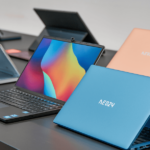Artificial Intelligence (AI) is fundamentally reshaping the landscape of desktop computing. In 2025, desktops are no longer just hardware-dependent machines; they are intelligent systems that adapt to user needs, enhance productivity, and redefine efficiency. From performance optimization to personalized user experiences, AI in desktop computing is leading the charge toward a smarter, more connected future.

In 2025, desktop computing is at the forefront of technological innovation, thanks to Artificial Intelligence (AI). By integrating AI capabilities, desktops have evolved into intuitive, adaptive systems that anticipate user needs, optimize performance, and ensure security. Whether you’re a gamer, a professional, or a casual user, AI has redefined how we interact with and benefit from our desktop PCs.
What is AI in Desktop Computing?
AI in desktop computing refers to the application of machine learning, neural networks, and advanced algorithms to enhance the functionality and usability of desktop systems. This integration enables desktops to:
- Predict user preferences.
- Optimize system resources automatically.
- Improve security by detecting and mitigating threats in real-time.
AI transforms desktops from static devices into intelligent systems capable of evolving alongside user needs.
AI-Driven Performance Optimization in Computing
AI optimizes desktop performance in several ways:
- Dynamic Resource Allocation
AI manages CPU, GPU, and RAM usage based on active tasks, ensuring optimal performance without manual intervention. For example, background tasks can be deprioritized while gaming or rendering. - Predictive Maintenance
AI systems monitor hardware health, predicting potential failures and recommending timely updates or repairs. - Real-Time System Updates
AI ensures drivers, firmware, and software are always up-to-date, reducing compatibility issues.
Personalized User Experience
AI customizes desktop environments to suit individual users:
- Adaptive Interfaces
Desktops now adjust layouts, themes, and workflows based on user preferences and habits. - AI-Powered Assistants
Virtual assistants, such as Cortana, Siri, and AI-enhanced chatbots, provide hands-free solutions for scheduling, research, and troubleshooting tasks. - Learning User Behavior
AI learns user behaviour patterns to offer shortcuts, reminders, and relevant recommendations, improving overall productivity.
Smart Security Solutions
AI has revolutionized desktop security by offering:
- Real-Time Threat Detection
AI monitors network traffic, identifying and neutralizing potential threats before they cause harm. - Adaptive Defenses
AI evolves alongside emerging threats, ensuring desktops remain secure against the latest malware and cyberattacks. - Biometric Security Enhancements
Advanced AI-powered facial recognition, fingerprint scanning, and voice authentication strengthen access control.
AI and Creative Workflows in Desktop Computing
For creators, AI is a game-changer:
- Video Editing
AI automates repetitive tasks, such as clipping and colour grading, allowing creators to focus on storytelling. - Graphic Design
AI suggests layouts, improves image quality, and enhances designs through automated tools. - Music Production
AI generates beats, harmonies, and arrangements, aiding musicians in composing complex tracks faster.
Voice and Gesture Integration
AI enables seamless interaction with desktops through:
- Voice Commands
AI-powered systems understand natural language commands, simplifying tasks like opening apps or searching files. - Gesture Recognition
Cameras equipped with AI detect hand gestures, offering a touch-free interface for presentations or media control.
AI in Gaming Desktops Computing
Gaming is one of the biggest beneficiaries of AI:
- Enhanced Gameplay
AI creates smarter non-player characters (NPCs) and adapts difficulty levels dynamically. - Adaptive Graphics
AI optimizes game settings for the best balance between performance and visual quality. - Real-Time Optimization
AI analyzes gameplay to minimize latency and ensure smooth frame rates.
AI and Work Productivity
AI enhances workplace efficiency through:
- Streamlined Multitasking
AI prioritizes tasks, allocates resources, and helps users manage workflows. - AI-Assisted Project Management
Tools like Trello and Asana now integrate AI for task delegation, deadline tracking, and resource allocation. - Collaboration Tools
AI improves virtual meetings by transcribing conversations, suggesting action items, and analyzing engagement.
Impact on Operating Systems
AI has become a cornerstone for operating systems:
- Windows 11 Pro AI Edition
Offers predictive file organization, adaptive notifications, and intelligent search functionalities. - macOS Sonoma AI Features
Apple’s focus on AI enhances system performance, photo organization, and creative tools. - Linux Distributions with AI
Open-source AI tools bring customizable smart features to Linux desktops.
Hardware Innovations Fueled by AI
AI is driving innovations in desktop hardware, such as:
- AI Chips: Dedicated processors like NVIDIA’s Tensor Cores accelerate AI tasks.
- GPU Enhancements: AI enhances ray tracing and real-time rendering for creative professionals and gamers.
- AI-Optimized Storage: Intelligent data caching reduces load times and increases efficiency.
Sustainability and Energy Efficiency
AI makes desktops eco-friendly by:
- Power Management
AI minimizes energy consumption by dynamically adjusting power usage based on workload. - Eco-Friendly Practices
Desktops are now built with AI-designed components to reduce electronic waste and carbon footprints.
The Role of Edge Computing and AI
Edge computing brings AI processing closer to users by:
- Reducing latency for AI applications.
- Enhancing performance for real-time tasks.
- Ensuring data privacy by processing sensitive information locally.
Challenges and Ethical Concerns
Despite its benefits, AI poses challenges:
- Data Privacy
AI systems collect and analyze large amounts of personal data, raising privacy concerns. - Security Risks
As AI grows more powerful, it could become a target for hackers. - Misuse of Technology
There’s a risk of AI being misused for surveillance or malicious purposes.
Future Trends in AI-Powered Desktops
The future of AI in desktop computing includes:
- Greater integration of AI across all software and hardware components.
- Advanced AI assistants are capable of near-human interaction.
- Modular desktops designed with AI for seamless upgrades.
Conclusion
AI is revolutionizing desktop computing, turning PCs into adaptive, intelligent systems that enhance every aspect of work, play, and creativity. In 2025, combining AI-driven performance, smarter security, and personalized experiences cements desktops as essential tools in a rapidly evolving digital landscape.
FAQs
- How is AI used in desktop computing?
AI enhances performance, personalizes user experiences, improves security, and optimizes workflows. - What are the benefits of AI in desktop PCs?
AI delivers better performance, smarter multitasking, enhanced gaming, and improved creative tools. - Which operating systems use AI?
Windows, macOS, and Linux all integrate AI to improve functionality and user experience. - What hardware innovations are driven by AI?
AI chips, GPUs, and intelligent storage systems are major advancements. - Are AI-powered desktops secure?
While AI enhances security, it also requires robust safeguards to protect against misuse. - What’s next for AI in desktop computing?
The future includes modular designs, advanced assistants, and broader AI integration across all systems.





